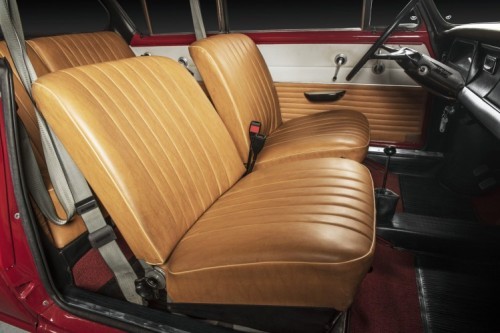The Škoda 1000 MBX De Luxe made its debut in March 1966 at the Geneva International Motor Show. The spacious five-seater car with the rear engine and rear-wheel drive went into production in October of the same year. It became an exotic for Eastern European standards at the time.
The MBX was based on the four-door Škoda 1000 MB production model, which relied on a modern monocoque body structure and an engine mounted behind the rear axle. In the early 60s, Škoda built a completely new factory for the production of the Škoda 1000 MB in the immediate vicinity of the existing production facility in Mladá Boleslav. The new factory consisted of modern facilities with more than forty production halls and various other buildings on an area of 80 hectares.
Special characteristics
The history of the two-door MBX goes back to 1960, when the two prototypes of the Škoda 990 Tudor were built. The special body - with distinctly inward-sloping C-pillars that merged with the panoramic rear window and the two doors with window-less mullions - was designed at the Kvasiny factory. The bodywork retained the space of the original sedan, with an improved (out) view. Not only could the driver and front passenger lower their door windows, the rear passengers could also open narrow windows in the rear. In addition, the triangular C-pillar windows could be folded out for extra ventilation.

Debut in Geneva
The Škoda 1000 MBX De Luxe was first presented to the public on 10 March 1966 at the Geneva Motor Show. The model surprised visitors with its original shapes. The two-door model gave the impression of not having a B-pillar due to the large glass surfaces. That B-pillar ended in the center of the bodywork below the window line, with the narrower top section able to be turned down together with the windows.
Produced labor-intensive
The Škoda 1000 MBX was powered by a 988-cylinder petrol engine with a displacement of XNUMX cm3 and a power output of 38 kW / 52 hp at 5.000 rpm. With an empty weight of 815 kg and a load capacity of 375 kg, the car reached a top speed of 127 km / h. The fuel consumption was between 7,8 and 8,0 liters of gasoline on 100 km. The model was equipped with two Jikov carburetors as standard; an engine with a single carburetor was fitted in only a few cases. The time-intensive assembly of the ŠKODA 1000 MBX, which took many man-hours, started 1966 in the stand-alone part of the Mladá Boleslav plant in October, so that the main production line was not delayed. The last twelve MBX models of the total 1.403 copies of the 1-liter version rolled early 1968 off the production line.

MBX important for foreign popularity
In November 1967, the model range of the brand was expanded with the sporty 1100 MBX De Luxe. The engine power remained unaffected with a displacement of 1.107 cm3, but the advantage was that the torque increased from 75,5 to 81,4 Newtonmeter. Other improvements were a more powerful oil pump and more efficient cooling. 1969 1.114 units were built from this stronger version, bringing the total number of two-door MBX versions to 2.517. Despite the relatively low production volume compared to the 1000 MB series production model (443.156 cars), this version significantly boosted the popularity of the ŠKODA brand in many demanding foreign markets. The legendary Coupé ŠKODA 110 R (1970-1980) gave an appropriate follow-up to the success of the attractive two-door MBX version, followed by the Garde and Rapid models.




In 1967 we would become daeler, everything was completed in Voorschoten so a week later it was canceled for Nijmegen, another dealer was appointed who at that time had bought a nice dealership with an even nicer location, it was a pity that the moment was sold reasonably well even this.Gr.Stef.
Lada 1200 cost 80000 francs in Belgium
Skoda cost Fr. 75000
Zastava 750 (Fiat 600) was the cheapest with 69000 fr (1 euro = 40 fr)
My father beckoned to a Skoda. Was a bit stronger (motorized, at least on paper) than our Ami. My brother and I have been able to avoid this parental error.
If it had another “Name Tag” on it, it would have sold better. Nice thing but idd quite labor intensive. It was also not smooth enough for what it radiated, even at that time. Thanks Erik for this article.
Greetings from a warm YVR,
Bass.
These were priced even cheaper than a Lada.
The coupe version in particular was beautifully lined.
Sold en masse in Belgium in the 70s and unfortunately also thrown away as massively because they were so cheaply priced.
The MBX and the Lada have never been sold at the same time.
Maybe you mean its successor, the Skoda S110R Coupé. It was about as expensive / cheap as the Lada 1200S, just under 10.000 guilders in the Netherlands. the sedans were of course cheaper. The Skodas were therefore slightly lower in the ranking than the Ladas, also in Czechoslovakia.
indeed, I was talking about the successor from the early 70s and I also meant the normal sedan.